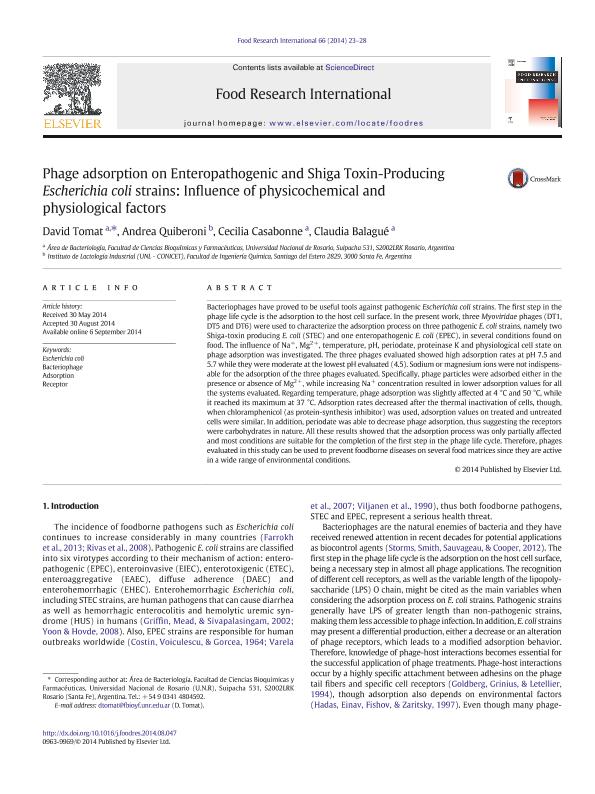Mostrar el registro sencillo del ítem
dc.contributor.author
Tomat, David Damian

dc.contributor.author
Quiberoni, Andrea del Lujan

dc.contributor.author
Casabonne, Cecilia
dc.contributor.author
Balagué, Claudia
dc.date.available
2017-02-21T16:02:30Z
dc.date.issued
2014-12
dc.identifier.citation
Tomat, David Damian; Quiberoni, Andrea del Lujan; Casabonne, Cecilia; Balagué, Claudia; Phage adsorption on Enteropathogenic and Shiga Toxin-Producing Escherichia coli strains: influence of physicochemical and physiological factors; Elsevier Science; Food Research International; 66; 12-2014; 23-28
dc.identifier.issn
0963-9969
dc.identifier.uri
http://hdl.handle.net/11336/13247
dc.description.abstract
Bacteriophages have proved to be useful tools against pathogenic Escherichia coli strains. The first step in the phage life cycle is the adsorption to the host cell surface. In the present work, three Myoviridae phages (DT1, DT5 and DT6) were used to characterize the adsorption process on three pathogenic E. coli strains, namely two Shiga-toxin producing E. coli (STEC) and one enteropathogenic E. coli (EPEC), in several conditions found on
food. The influence of Na+, Mg2+, temperature, pH, periodate, proteinase K and physiological cell state on phage adsorption was investigated. The three phages evaluated showed high adsorption rates at pH 7.5 and 5.7 while they were moderate at the lowest pH evaluated (4.5). Sodium or magnesium ions were not indispensable for the adsorption of the three phages evaluated. Specifically, phage particles were adsorbed either in the presence or absence of Mg2+, while increasing Na+ concentration resulted in lower adsorption values for all
the systems evaluated. Regarding temperature, phage adsorption was slightly affected at 4 °C and 50 °C, while it reached its maximum at 37 °C. Adsorption rates decreased after the thermal inactivation of cells, though, when chloramphenicol (as protein-synthesis inhibitor) was used, adsorption values on treated and untreated
cells were similar. In addition, periodate was able to decrease phage adsorption, thus suggesting the receptors were carbohydrates in nature. All these results showed that the adsorption process was only partially affected and most conditions are suitable for the completion of the first step in the phage life cycle. Therefore, phages evaluated in this study can be used to prevent foodborne diseases on several food matrices since they are active in a wide range of environmental conditions.
dc.format
application/pdf
dc.language.iso
eng
dc.publisher
Elsevier Science

dc.rights
info:eu-repo/semantics/openAccess
dc.rights.uri
https://creativecommons.org/licenses/by-nc-sa/2.5/ar/
dc.subject
Escherichia Coli
dc.subject
Bacteriophage
dc.subject
Adsorption
dc.subject
Receptor
dc.subject.classification
Biología Celular, Microbiología

dc.subject.classification
Ciencias Biológicas

dc.subject.classification
CIENCIAS NATURALES Y EXACTAS

dc.title
Phage adsorption on Enteropathogenic and Shiga Toxin-Producing Escherichia coli strains: influence of physicochemical and physiological factors
dc.type
info:eu-repo/semantics/article
dc.type
info:ar-repo/semantics/artículo
dc.type
info:eu-repo/semantics/publishedVersion
dc.date.updated
2016-11-23T20:13:54Z
dc.journal.volume
66
dc.journal.pagination
23-28
dc.journal.pais
Países Bajos

dc.journal.ciudad
Amsterdam
dc.description.fil
Fil: Tomat, David Damian. Universidad Nacional de Rosario. Facultad de Cs.bioquimicas y Farmaceuticas. Departamento de Microbiologia; Argentina
dc.description.fil
Fil: Quiberoni, Andrea del Lujan. Consejo Nacional de Investigaciones Científicas y Técnicas. Centro Científico Tecnológico Santa Fe. Instituto de Lactologia Industrial; Argentina
dc.description.fil
Fil: Casabonne, Cecilia. Universidad Nacional de Rosario. Facultad de Cs.bioquimicas y Farmaceuticas. Departamento de Microbiologia; Argentina
dc.description.fil
Fil: Balagué, Claudia. Universidad Nacional de Rosario. Facultad de Cs.bioquimicas y Farmaceuticas. Departamento de Microbiologia; Argentina
dc.journal.title
Food Research International

dc.relation.alternativeid
info:eu-repo/semantics/altIdentifier/doi/http://dx.doi.org/10.1016/j.foodres.2014.08.047
Archivos asociados
